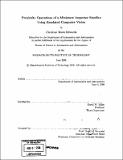Proximity operations of a miniature inspector satellite using emulated computer vision
Author(s)
Edwards, Christine Marie
DownloadFull printable version (39.49Mb)
Other Contributors
Massachusetts Institute of Technology. Dept. of Aeronautics and Astronautics.
Advisor
David W. Miller.
Terms of use
Metadata
Show full item recordAbstract
If a micrometeoroid, a piece of space junk, launch debris, or a major system failure impacts the Crew Exploration Vehicle (CEV), it can cause life-threatening damage. Past International Space Station (ISS) and Space Shuttle repair missions have shown that inspection of a damaged system is crucial for planning the EVA to repair it. To assist the CEV team with inspection and contingency planning, an inspector satellite can be an essential tool. This thesis presents the idea of using a miniature satellite to inspect the CEV for damage while flying in formation. In this research, the satellite test bed SPHERES has been used to develop, demonstrate, and flight-test an inspector-satellite operations design and controller. The design utilizes an autonomous control algorithm that combines Linear Quadratic Regulator (LQR) and Artificial Potential Field (APF) control. This controller is designed to navigate through waypoints, follow the contours of an inspected spacecraft's surface, avoid obstacles, operate in real-time onboard the inspector satellite, work with or without a-priori knowledge of the inspected spacecraft's geometry, interface with a computer-vision system, and handle the loss of computer-vision information. Since the SPHERES camera system is currently under development, computer vision data was emulated using the current SPHERES global metrology. Results from simulations and successful flight tests aboard the ISS are discussed.
Description
Thesis (S.M.)--Massachusetts Institute of Technology, Dept. of Aeronautics and Astronautics, 2008. Includes bibliographical references (p. 115-117).
Date issued
2008Department
Massachusetts Institute of Technology. Department of Aeronautics and AstronauticsPublisher
Massachusetts Institute of Technology
Keywords
Aeronautics and Astronautics.